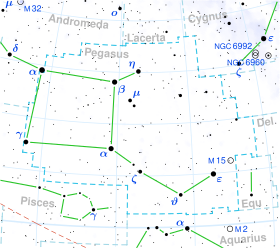| Observation data Epoch J2000.0 Equinox J2000.0 | |
|---|---|
| Constellation | Pegasus |
| Right ascension | 22h 09m 13.61893s[1] |
| Declination | +33° 10′ 20.4778″[1] |
| Apparent magnitude (V) | +5.58[2] |
| Characteristics | |
| Spectral type | G8IIIb[3] |
| B−V color index | +0.985±0.003[2] |
| Astrometry | |
| Radial velocity (Rv) | +5.1±0.9[4] km/s |
| Proper motion (μ) | RA: −48.117[1] mas/yr Dec.: −73.408[1] mas/yr |
| Parallax (π) | 10.2111 ± 0.1137 mas[1] |
| Distance | 319 ± 4 ly (98 ± 1 pc) |
| Absolute magnitude (MV) | 0.84[5] |
| Details | |
| Mass | 2.48[6] M☉ |
| Radius | 11.00+0.51 −0.83[1] R☉ |
| Luminosity | 62.8±0.8[1] L☉ |
| Surface gravity (log g) | 2.7[7] cgs |
| Temperature | 4,898+196 −110[1] K |
| Metallicity [Fe/H] | −0.22[5] dex |
| Rotational velocity (v sin i) | 135[7] km/s |
| Age | 530[6] Myr |
| Other designations | |
| Database references | |
| SIMBAD | data |
Pi1 Pegasi, Latinized from π1 Pegasi, is a star in the constellation Pegasus. Based upon changes to the proper motion of the visible component, this is a probable astrometric binary.[9] It has a yellow hue and is dimply visible to the naked eye with a combined apparent visual magnitude of +5.58.[2] The system is located approximately 319 light years distant from the Sun based on parallax,[1] and is drifting further away with a radial velocity of +5 km/s.[4] It is a member of the Ursa Major Moving Group of co-moving stars.[10]

The visible component is an aging giant star with a stellar classification of G8IIIb.[3] It has a high rate of spin, with a projected rotational velocity of 135 km/s.[7] This is giving it an equatorial bulge that is 17% larger than the polar radius.[11] It is a shell star, being orbited by a circumstellar shell of cooler gas.[12][13] This star is 530[6] million years old with 2.5[6] times the mass of the Sun. With the supply of hydrogen exhausted at its core, the star has cooled and expanded to 11[1] times the Sun's radius. It is radiating 63[1] times the luminosity of the Sun from its enlarged photosphere at an effective temperature of 4,898 K.[1]
- ^ a b c d e f g h i j k l Cite error: The named reference
GaiaDR2was invoked but never defined (see the help page). - ^ a b c Cite error: The named reference
Anderson2012was invoked but never defined (see the help page). - ^ a b Cite error: The named reference
abt1985was invoked but never defined (see the help page). - ^ a b Cite error: The named reference
Gontcharov2006was invoked but never defined (see the help page). - ^ a b Cite error: The named reference
Takeda2008was invoked but never defined (see the help page). - ^ a b c d Cite error: The named reference
luck2015was invoked but never defined (see the help page). - ^ a b c Cite error: The named reference
Massarotti2008was invoked but never defined (see the help page). - ^ Cite error: The named reference
SIMBADwas invoked but never defined (see the help page). - ^ Cite error: The named reference
Eggleton2008was invoked but never defined (see the help page). - ^ Cite error: The named reference
Schmitt1990was invoked but never defined (see the help page). - ^ Cite error: The named reference
vanBelle2012was invoked but never defined (see the help page). - ^ Cite error: The named reference
Hauck2000was invoked but never defined (see the help page). - ^ Cite error: The named reference
Slettebak1986was invoked but never defined (see the help page).
